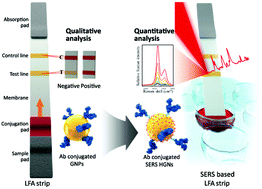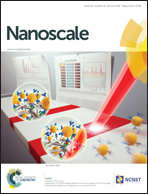Application of a SERS-based lateral flow immunoassay strip for the rapid and sensitive detection of staphylococcal enterotoxin B†
Abstract
A novel surface-enhanced Raman scattering (SERS)-based lateral flow immunoassay (LFA) biosensor was developed to resolve problems associated with conventional LFA strips (e.g., limits in quantitative analysis and low sensitivity). In our SERS-based biosensor, Raman reporter-labeled hollow gold nanospheres (HGNs) were used as SERS detection probes instead of gold nanoparticles. With the proposed SERS-based LFA strip, the presence of a target antigen can be identified through a colour change in the test zone. Furthermore, highly sensitive quantitative evaluation is possible by measuring SERS signals from the test zone. To verify the feasibility of the SERS-based LFA strip platform, an immunoassay of staphylococcal enterotoxin B (SEB) was performed as a model reaction. The limit of detection (LOD) for SEB, as determined with the SERS-based LFA strip, was estimated to be 0.001 ng mL−1. This value is approximately three orders of magnitude more sensitive than that achieved with the corresponding ELISA-based method. The proposed SERS-based LFA strip sensor shows significant potential for the rapid and sensitive detection of target markers in a simplified manner.


 Please wait while we load your content...
Please wait while we load your content...